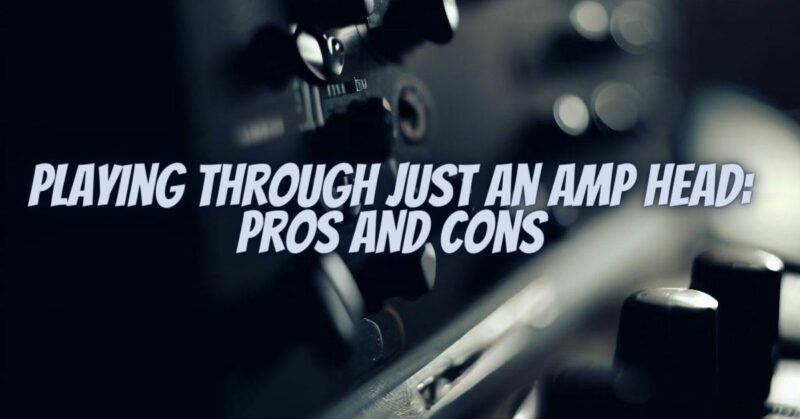In the world of guitar amplification, there’s a multitude of options to choose from when it comes to creating your ideal tone. One of the more unconventional approaches is playing through just an amp head, without a traditional speaker cabinet. This unique setup has both its advantages and disadvantages, and in this comprehensive article, we’ll explore the pros and cons of this minimalist approach to amplification.
Pros of Playing Through Just an Amp Head:
- Portability: Without the need for a speaker cabinet, your setup becomes incredibly portable. This is especially advantageous for gigging musicians who frequently move their gear from venue to venue. An amp head alone is lightweight and easy to transport.
- Recording and Silent Practice: Using just an amp head can be ideal for recording purposes or silent practice. Many modern amp heads come equipped with direct outputs or headphone jacks, allowing you to play silently or directly into a recording interface. This is a great solution for home studios and quiet practice sessions.
- Space Efficiency: When space is limited, such as in a small practice room or home studio, eliminating the need for a bulky speaker cabinet can make your setup more manageable and efficient.
- Tonal Flexibility: Some amp heads feature built-in amp modeling and speaker simulation capabilities. This means you can access a wide variety of tones without needing a physical speaker cabinet or additional effects processors.
- Customization: Playing through just an amp head gives you the freedom to connect to different speaker cabinets or load boxes, allowing you to customize your sound further. You can experiment with various cabinet types or sizes to achieve your desired tonal characteristics.
Cons of Playing Through Just an Amp Head:
- Limited Volume: Amp heads alone are not designed to produce sound at a level suitable for live performances. Without a speaker cabinet to project the sound, you’ll be limited to practice and recording volumes. This makes it unsuitable for most live gigs.
- Tonal Differences: The absence of a speaker cabinet can lead to a different tonal experience. The sound from the amp head alone may lack the warmth, presence, and character that a speaker cabinet provides. The response can be quite different, especially at higher volumes.
- Feedback Issues: When playing through just an amp head at high volumes, feedback can become a significant problem. The interaction between your guitar pickups and the amp head’s output can lead to uncontrollable squealing and noise.
- Incompatibility with Tube Amps: Many tube amp heads require an appropriate load (like a speaker cabinet) to safely operate. Running a tube amp head without a load can damage the amp’s output transformer or tubes.
- Reduced Projection: In a live band setting, a speaker cabinet helps project your sound to the audience and provides the necessary stage volume. Without a cabinet, your sound may not cut through the mix as effectively.
When to Consider Playing Through Just an Amp Head:
Playing through just an amp head can be a viable option in specific scenarios:
- Recording Studios: When recording guitar parts in a studio, the ability to capture a variety of tones and easily switch between them can make playing through an amp head alone a convenient choice.
- Home Practice and Silent Playing: For home practice or late-night silent playing, using an amp head with headphones or a direct output can be ideal, especially if you have neighbors or family members who don’t appreciate loud guitar volumes.
- Experimentation: Musicians who enjoy experimenting with different speaker cabinets or want to explore the capabilities of amp modeling and speaker simulation may find playing through just an amp head a valuable option.
In conclusion, playing through just an amp head has its pros and cons, and whether it’s a suitable choice depends on your specific needs and preferences. While it offers portability, tonal flexibility, and recording advantages, it comes with limitations in terms of volume, tonal character, and live performance suitability. If you decide to go this route, be sure to research and understand the compatibility of your amp head with various setups and always prioritize the safe operation of your gear. Ultimately, the decision should align with your playing style, the venues you perform in, and your sonic goals as a guitarist.


